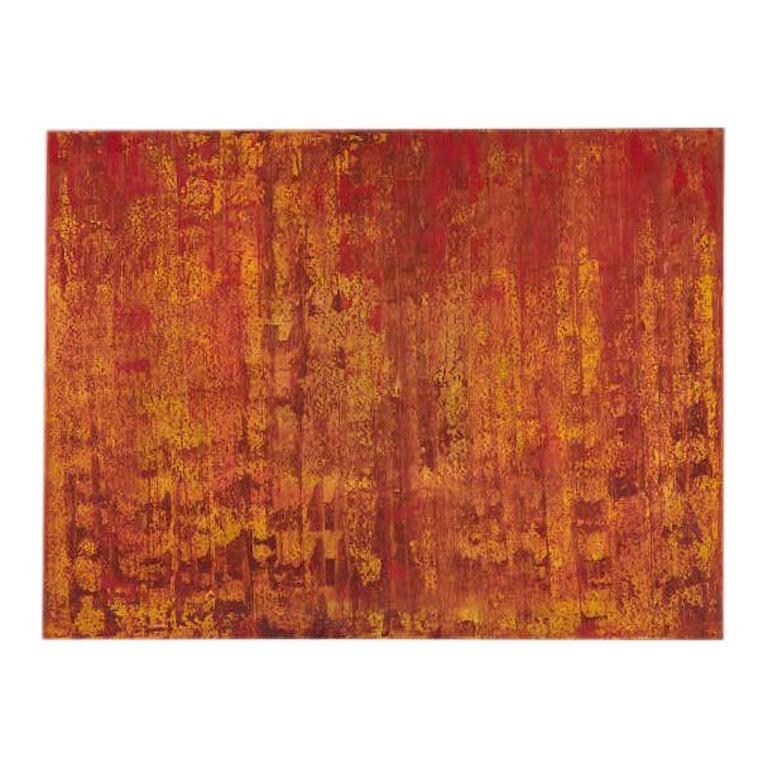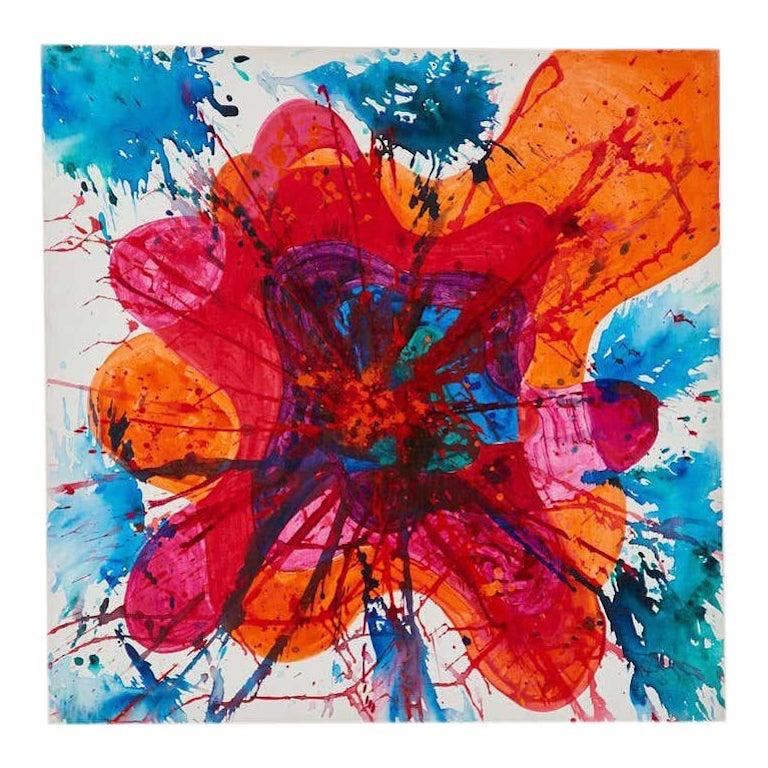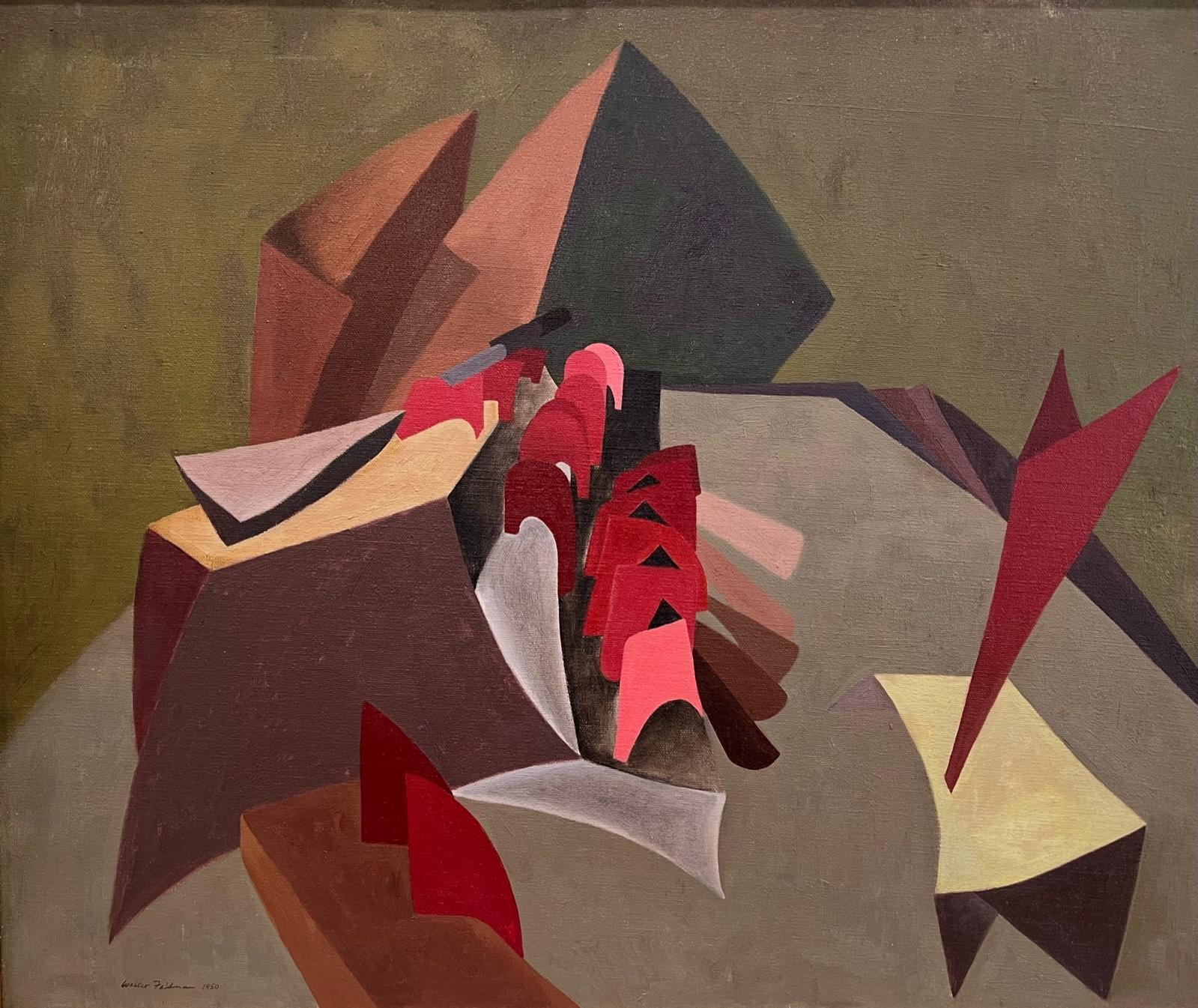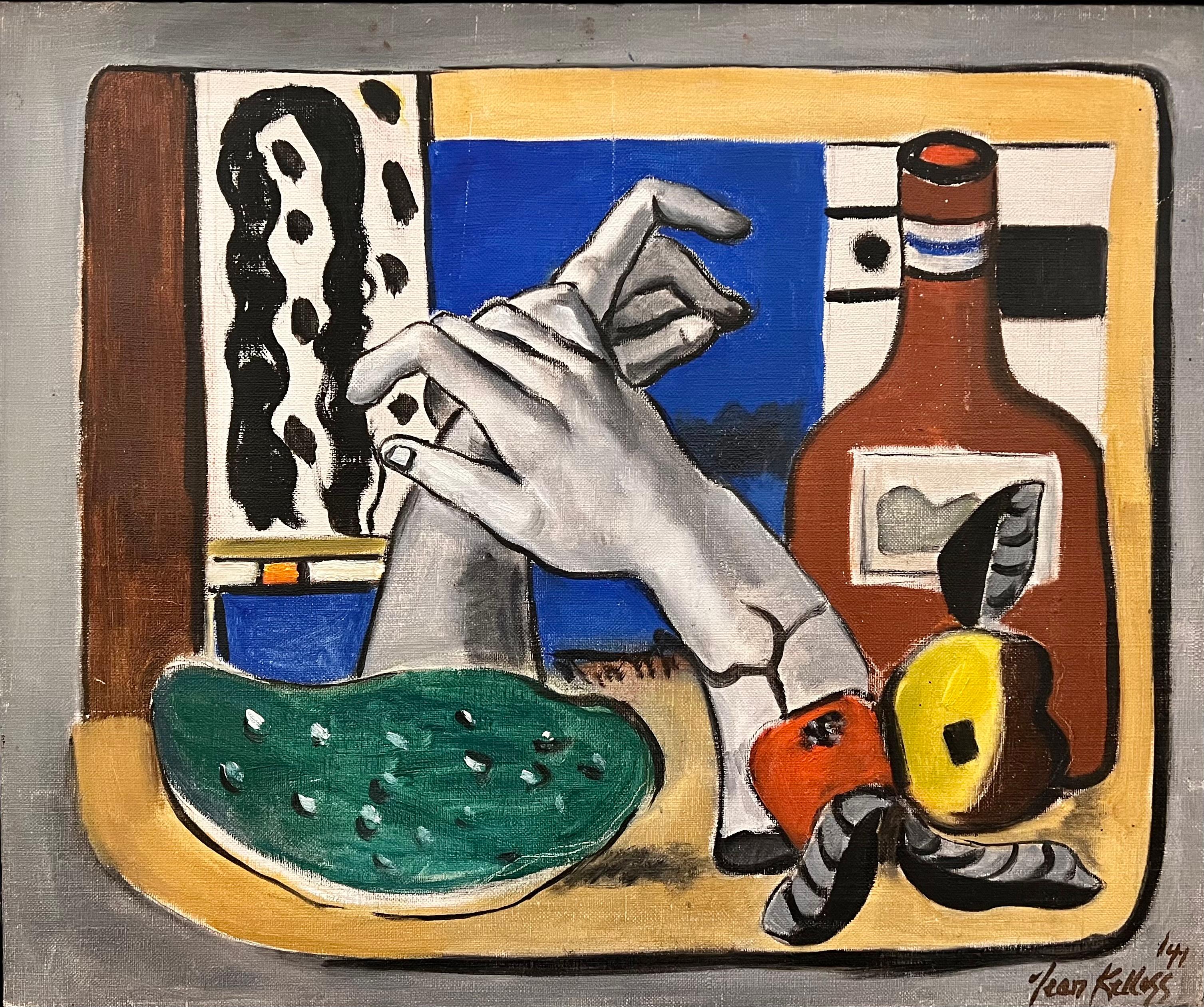Items Similar to "Martos, " 1960s Modern Abstract Painting
Want more images or videos?
Request additional images or videos from the seller
1 of 10
Stanley Bate"Martos, " 1960s Modern Abstract Paintingcirca 1960s
circa 1960s
About the Item
"Martos" is an abstract oil painting on canvas by Stanley Bate featuring what appears to be a high horizon line of white and muted yellow. Beneath that line is a combination of textured white, deep grey and umber shapes that come together and create an earthy palette and composition. The gallery wrapped canvas is framed in a silver-hued floater frame and measures 44" x 42" framed. Arrives wired and ready to hang.
Stanley Bate was born on March 26, 1903 in Nashville, Tennessee. The Bates were an established Tennessee family, in fact, Henry’s brother William Bate was the governor of Tennessee from 1883-1887 and a United States Senator from 1887-1905. Stanley studied art at the Watkins Institute in Nashville.
In the 1920’s Bate moved to New York City to study at the Art Students League under Frederick Bridgman. He soon landed a job with Encyclopedia Britannica, and from 1927-1929 served as art editor. From 1929 until his death in 1972, Stanley was a self-employed artist. He taught art classes at both the Art Students League and the Albany Institute of History and Art and brought in extra income by making illustrations for magazines such as “Outdoor Life” and “Popular Science”.
On January 27, 1934 Stanley married Emilie Rossel. Emilie had emigrated from Switzerland to New York in 1923. She found work as a governess to Alfred Vanderbilt and later as an executive secretary for Wall Street investment brokers Kahn, Loeb and Co. Emilie met Stanley in New York in the early 1930’s when she attended one of his art exhibitions with a friend. The couple, who had no children, lived on 34th Street in Manhattan. During this period, Bate was producing and exhibiting his art and joined several artists groups. Stanley and Emilie became part of the New York art scene, dining weekly at the Society of Illustrators Clubhouse.
Stanley Bate’s time in New York was pivotal in the formation of his painting style. He lived in New York during the inception of one of the most important Modern Art movements, one that helped New York replace Paris as the center of avant-garde art. This movement, which was called the New York School of artists, was later known as Abstract Expressionism. It was comprised of a loosely associated group of vanguard artists working in New York City during the 1940s and 1950s. The New York School was not defined by a specific style, but instead reflected a fusion of European Modernism and American social relevancy that was depicted in many individual styles. Influences of Surrealism, Cubism, and Modernism can be found in their work, along with an interest in experimenting with non-traditional materials and methods. American art was in the forefront of international avant-garde for the first time.
Stanley Bate was undoubtedly exposed to the varied styles and techniques that were emerging during the formative years of the New York School. Mark Rothko and Robert Motherwell were formulating their versions of color field paintings. Joseph Cornell was experimenting with assemblages, collage and the use of different types of textured paints. Jackson Pollock was adhering objects such as buttons and coins into his early works, while Louise Nevelson was using found objects. Helen Frankenthaler added sand to her early paintings. The New York School artists were undermining traditional fine art by using mixed media and non-traditional methods.
Stanley Bate absorbed these varied influences and soon his early realistic landscapes and still-lifes were replaced with something entirely new. The influence of Cubism, notably the flat shallow space of the picture plane, is obvious in many of Bate’s paintings. Surrealism is evident in Bate’s use of subjects from myth, primitive art and antiquity, along with the Automatism-like line work in his more linear images. The unfettered experimentation of the New York School is everywhere in Stanley Bate’s work. We see nods to color field, collage, the mixing of textures into paint, mixed media, the inclusion of found objects and thick, luscious impasto.
Bate was prolific and experimented in various media including oil, watercolor, lithography, silk screen, wood cut, drawing, collage, ceramics and sculpture. Bate is considered a true Modernist. His work is largely abstract, but sometimes figures and buildings are discernable. He frequently mixed paint, sand and glue together to achieve a textured surface, and then scraped and scratched through this layer to expose some of the underpainting below. His sculpture, which is often whimsical, also reflects the non-traditional methods of the New York School. Bate pioneered the use of enamel and copper in his work. The sculptures are not carved or modeled as was done in the past, but instead are built using mixed media and new materials.
In addition to the New York School influence, many of Bate’s works exhibit a strong connection to the Spanish school, especially the work of Antonio Tapies and Modesto Cuixart. These artists were both part of an avant-garde group known as Art Informel, the Spanish equivalent of Abstract Expressionism. These artists likewise worked in mixed media and introduced objects and texture into their work. Many of Bate’s subjects and titles relate to Spanish locations and words. It is likely that Stanley spent time in Spain and found inspiration there.
By the early 1940s, Stanley and Emilie had started spending weekends in a barn they purchased in Craryville, New York, a few hours north of Manhattan. The barn had no electricity or plumbing, but when the Bates eventually decided to leave New York and live full time in Craryville, they remodeled the barn, putting a gallery downstairs and a studio and living quarters upstairs. Although the Bates moved out of New York City, Stanley remained part of the New York art scene, exhibiting in New York and elsewhere throughout the 50s and 60s. During his lifetime he was represented by the New York galleries Knoedler and Company, Kennedy Galleries, Rose Fried Gallery and Key Gallery, along with Tyringham Gallery located in Tyringham, Massachusetts. Craryville was Stanley’s home until his death on August 21, 1972. Emilie died 1984. Her obituary requested that any donations to be made to the Albany Institute of History and Art. The Institute held a retrospective exhibition of Bate’s work in 1973. Since his death, Stanley Bate’s artwork has been exhibited widely and placed in numerous collections.
- Creator:Stanley Bate (1903 - 1972, American)
- Creation Year:circa 1960s
- Dimensions:Height: 42 in (106.68 cm)Width: 44 in (111.76 cm)Depth: 1.5 in (3.81 cm)
- Medium:
- Movement & Style:
- Period:
- Condition:Professionally framed in a 1 inch wide silver floater frame. 42 x 44 framed.
- Gallery Location:Westport, CT
- Reference Number:
About the Seller
5.0
Vetted Seller
These experienced sellers undergo a comprehensive evaluation by our team of in-house experts.
Established in 2009
1stDibs seller since 2014
378 sales on 1stDibs
Typical response time: <1 hour
- ShippingRetrieving quote...Ships From: Albany, NY
- Return PolicyThis item cannot be returned.
More From This SellerView All
- "Abduction of the Emperor, " 1970s Modern Abstract PaintingBy Stanley BateLocated in Westport, CT"Abduction of the Emperor" by Stanley Bate is an abstract oil painting made in 1971. This piece is primarily a textured sandy gold color with geometric shapes that add pops of light ...Category
1970s Modern Abstract Paintings
MaterialsCanvas, Oil
- "Georgia on My Mind, " 1960s Modern Abstract PaintingBy Stanley BateLocated in Westport, CTThis original Modern abstract piece by Abstract Expressionist Stanley Bate features a warm, earthy palette. In it, organic and rectangular shapes are layered with deep teal and creme...Category
1960s Modern Abstract Paintings
MaterialsCanvas, Oil
- "Paphos, " 1960s Modern Abstract PaintingBy Stanley BateLocated in Westport, CTThis textured, Modern Abstract Expressionist painting Stanley Bate features a neutral palette with both warm and cool undertones. Muted blues and reds seem to be incorporated into a ...Category
1960s Modern Abstract Paintings
MaterialsCanvas, Oil
- "Entr' Acte, " 1960s Modern Abstract PaintingBy Stanley BateLocated in Westport, CTThis Modern abstract figurative painting by Stanley Bate features abstracted figures in motion, placed in front of a geometric background with white, maroon, and blue squares tiled n...Category
1960s Modern Abstract Paintings
MaterialsOil, Canvas
- "Untitled #296 (Modern), " 1960s Modern Abstract PaintingBy Stanley BateLocated in Westport, CTThis Modern painting by Abstract Expressionist painter Stanley Bate features a textured aesthetic and a deep, colorful palette. Deep blue and red is contrasted by a brighter accents ...Category
1960s Modern Abstract Paintings
MaterialsCanvas, Oil
- "Untitled #144, " 1960s Modern Abstract PaintingBy Stanley BateLocated in Westport, CTThis Modern painting by Abstract Expressionist Stanley Bate was made with oil on canvas circa 1960. In it, layers of red, yellow, white, and umber paint are expressively applied over...Category
1960s Modern Abstract Paintings
MaterialsCanvas, Oil
You May Also Like
- Modern Abstract Oil PaintingLocated in Rio Vista, CADramatic abstract oil on canvas painting by Gladys Regier-Vaughan (American 1923-1987). Vaughan was a New York stage director who started painting in 1970. Signed and dated verso.Category
20th Century Modern Abstract Paintings
MaterialsCanvas, Oil
- The Red Forest Modern AbstractLocated in Rio Vista, CAModern abstract oil on canvas painting titled "The Red Forest" and dated 2007 verso. Signed by Artist bottom left corner verso. Beautiful thick textures and...Category
21st Century and Contemporary Modern Abstract Paintings
MaterialsCanvas, Oil
- Cangiante ArancioneBy Giulio TurcatoLocated in Firenze, FIGiulio Turcato (Mantova, 16 marzo 1912 – Roma, 22 gennaio 1995) è stato un artista italiano, fra i principali esponenti dell'astrattismo informale italiano.Category
1980s Modern Abstract Paintings
MaterialsCanvas, Mixed Media, Oil
- The OrchestraLocated in Los Angeles, CAThe Orchestra, 1950, oil on canvas, 21 ½ x 25 3/4 inches, signed and dated lower left, labeled verso “Brown University, Trustee, The Walter Feldman Trus...Category
Mid-20th Century American Modern Abstract Paintings
MaterialsCanvas, Oil
- Homage to LegerBy Jean KelloggLocated in Los Angeles, CAThis painting is part of our exhibition America Coast to Coast: Artists of the 1940s. Homage to Leger, 1941, oil on canvas, signed and dated lower right, 14 x 17 inches; inscribed ...Category
1940s American Modern Paintings
MaterialsCanvas, Oil
- Amish Farmscape #3By Edmund LewandowskiLocated in Los Angeles, CAAmish Farmscape #3, 1984, oil on canvas, 40 x 30 inches, signed and dated lower right; signed, dated, and titled verso About the Painting Amish Farmscape #3 is part of a multi-painting series of barns completed in the early 1980s for an exhibition at New York’s prestigious Sid Deutsch Gallery. Lewandowski painted this work at an important point in his career. It was the first major project undertaken by Lewandowski after his retirement from serving as the Chairman of Winthrop University’s Art Department, the last academic position he held after teaching for nearly thirty years. Lewandowski had been inspired to work on the series by a visit to Lancaster County, Pennsylvania. Like his friend and mentor, Charles Sheeler, Lewandowski had always been fascinated by vernacular architecture and the Amish barns of Pennsylvania brought back memories of rural scenes Lewandowski had painted in the Midwest much earlier in his career. Amish Farmscape #3 is a strong example of Lewandowski’s late precisionist work. The complexity of the composition and Lewandowski’s technical acumen are on full display. Being relieved of the burdens of teaching and administering a university art department likely allowed Lewandowski greater freedom and most importantly more time to complete the Amish Farmscape series. Although Lewandowski’s brand of precisionism changed throughout the years, he never deviated from the core tenets of the Immaculate School artists. In this work, we see simplified and flattened forms, the use of ray-lines to define light and space, the elimination of extraneous details, a polished almost machine-like finish, and the complete lack of visible brushstrokes, all hallmarks of the precisionist painters. Lewandowski was the last of the 20th century precisionists and in Amish Farmscape #3, we see just how successfully he continued to work in this style until his death in 1998. About the Artist Edmund Lewandowski was among the best of the second-generation precisionist painters. He was born and raised in Milwaukee, Wisconsin and studied at the Layton School of Art with Garrett Sinclair. Lewandowski achieved early success when in 1936 two of his watercolors were shown at the Phillips Collection as part of a Federal Art Project exhibition. Then, in 1937, his work was first exhibited at Edith Halpert’s Downtown Gallery which represented Lewandowski into the 1950s. Under Halpert’s guidance, Lewandowski continued to explore watercolor as his main medium during the 1930s and 1940s, since the gallery already represented Charles Sheeler, who worked primarily in oils. Sheeler became Lewandowski’s major influence as the primary leader of the ill-defined, but very recognizable Immaculate School artists, which included other Downtown Gallery painters, Niles Spencer, George Ault, and Ralston Crawford, as well as Charles Demuth and Preston Dickinson, both of whom died at a young age and had been represented by the Charles Daniel Gallery. Sheeler is credited with giving Lewandowski technical advice on how to make his paintings more precise and tightly rendered and by all accounts, Sheeler was a fan of Lewandowski’s work. Through the Downtown Gallery, Lewandowski’s paintings were accepted into major national and international exhibitions and purchased by significant museums and collectors. Franklin and Eleanor Roosevelt and Nelson Rockefeller acquired works by Lewandowski. He was included in the Museum of Modern Art’s important 1943 exhibition, American Realists and Magic Realists as well as juried exhibitions at the Whitney Museum of American Art, the Pennsylvania Academy of Fine Arts, and the Art Institute of Chicago. Lewandowski also completed commissions for magazines during the 1940s and 1950s, including several covers for Fortune. Throughout his career, Lewandowski explored urban and rural architecture, industry, machinery, and nautical themes. Looking back on his career, Lewandowski wrote, “My overwhelming desire as an artist through the years has been to record the beauty of man-made objects and energy of American industry on canvas. For as far back as I can recall, the cityscapes, farms and depictions of industrial power and technological efficiency has had a great attraction for me. I try to treat these observations with personal honesty and distill these impressions to a visual order.” Lewandowski is credited with extending precisionism to the Midwest and successfully continuing the style into the 1990s, three decades after Sheeler’s death and six decades after Demuth’s passing. Late in his career, Lewandowski enjoyed a resurgence of popularity as he was represented during the 1980s by New York’s Sid Deutsch and Allison Galleries...Category
Mid-20th Century American Modern Landscape Paintings
MaterialsCanvas, Oil
Recently Viewed
View AllMore Ways To Browse
1960s Modern Art
1960s Modern Painting
1960s Painting Canvas
Modern Surrealism
Mixing Vintage With Modern
Mixing Modern With Vintage
Modern 60s Art
Modern Retro Illustration
Modern Art From 60s
1920 Modern Painting
1920s Style Paintings
Modern 21s
Couple 1960s
Early Massachusetts Paintings
1960s Oil Paintings Cities
Dior 1984
1930s American Abstract Art
1960s Paris Oil Painting





